2431
Видео / Re: И в этом тоже замешан RedBull ;)
« : 05.11.2016, 01:36:42 »
А если так же на спинакере вместо парашюта? 

|
Для создания НОВОГО ПОСТА, необходимо выбрать нужный раздел ФОРУМА и создать в нем НОВУЮ ТЕМУ. Если вы новый пользователь, то вам нужно ЗАРЕГИСТРИРОВАТЬСЯ на форуме В этом разделе можно просмотреть все сообщения, сделанные этим пользователем. 2431
Видео / Re: И в этом тоже замешан RedBull ;)« : 05.11.2016, 01:36:42 »
А если так же на спинакере вместо парашюта?

2432
Your topic / I'm 15 Years Old And I Grew Up on a Boat« : 25.10.2016, 22:39:12 »
Like a real-life Zack and Cody, I've spent the past 7 years traveling the world
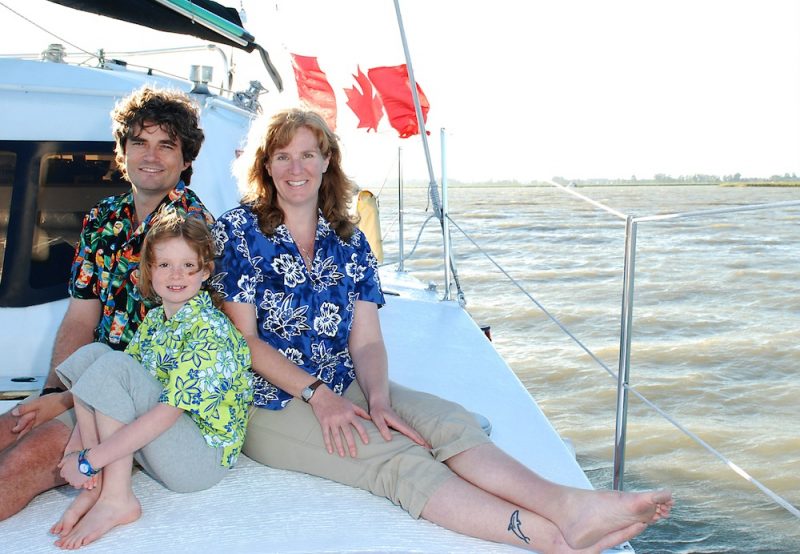 Maia and her family then I was seven years old when my parents and I sailed away from Vancouver, BC, the city where I had grown up. Our plan was to sail around the world, and return. One day. We didn't really have a timeframe; we were just going to do it. And I was OK with that. I was seven, and I was going to see dolphins and mermaids and pirates, and I would play on tropical beaches and pick coconuts and dive for clams. 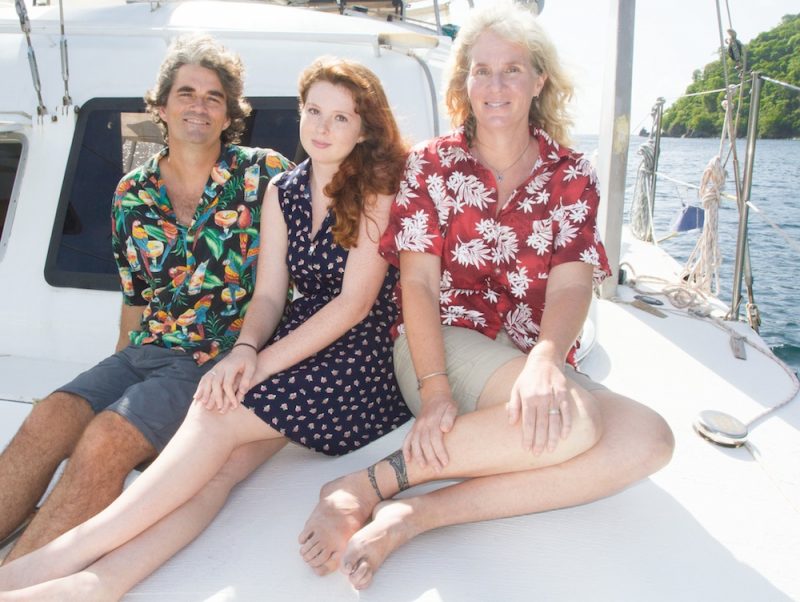 Maia and her family now My boat, Ceilydh (pronounced Kay-lee), is a 40-foot two-hulled catamaran. My room is a cave-like bed, with just enough space to sit up straight. Three steps away from my bedroom is the main cabin. It serves as dining room, living room, office, and classroom. Windows all around the boat can be opened to provide a breeze even on the hottest of days. 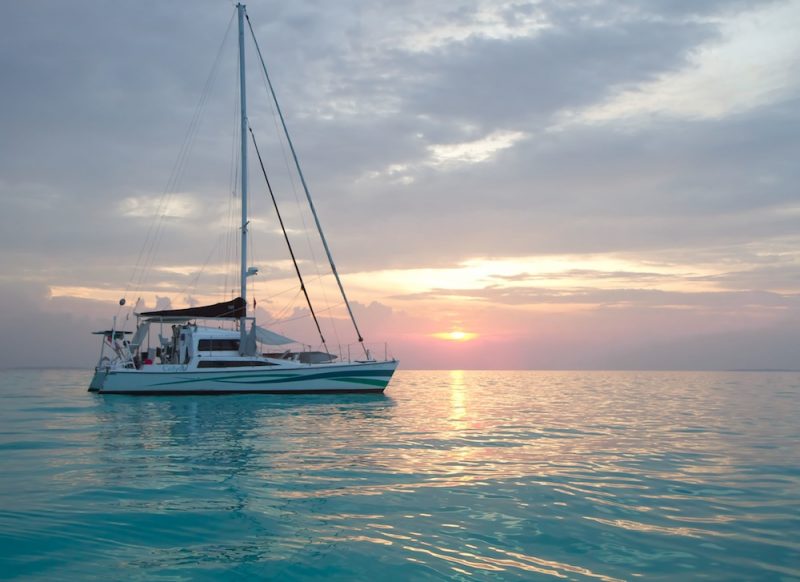 Ceilydh at anchor in the Maldives 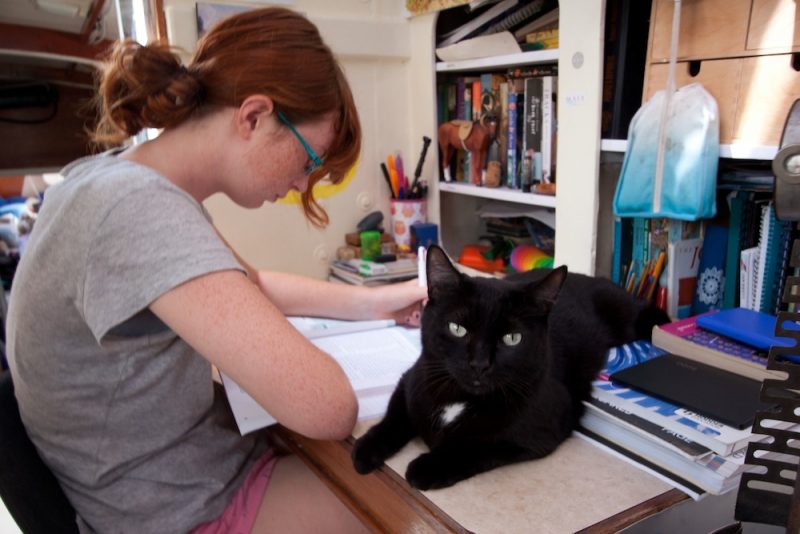 Maia in her bedroom alongside Charlie the cat It's a pretty house, but it's very small. There's limited privacy. I can't even resort to the age-old teenager trick of slamming my door — because I don't have one. People always ask how I go to school, eyes wide at my unconventional childhood. "Are you just taking a vacation?" they ask. "No," I tell them. "This is my life and I'm boat-schooled." My writer mother helps me with English and history, and my naval architect father assists with math and science (although he readily admits that biology baffles him). 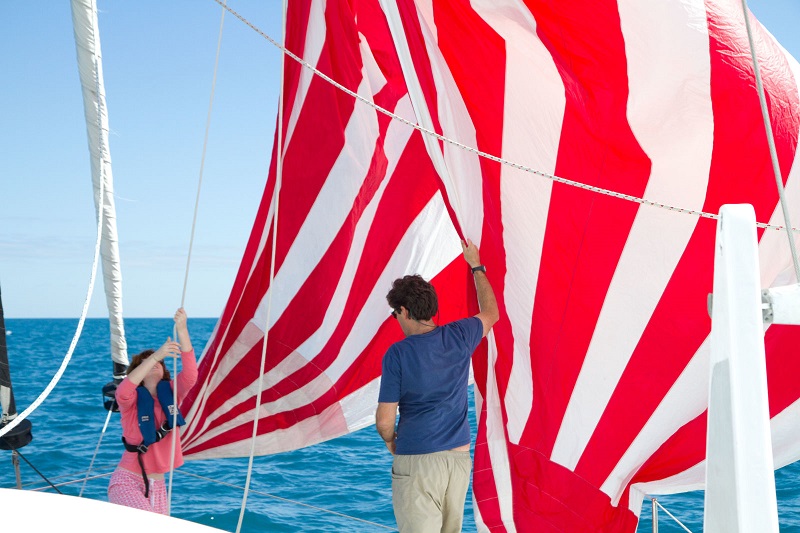 Helping Dad with the sails I also get questions about pirates. We have never been in danger from pirates, basically because we give the places with pirates a wide berth. I did watch Pirates of the Caribbean at a movie night in Mexico, however. But that was the closest I ever got to the skull and crossbones. DATING: THE STRUGGLE IS REAL The sailing community isn't very big, so we all kind of know each other. That can make dating difficult. This was especially bad in Madagascar. We'd been sailing with a group of boats, and one of the boys and I were sort-of-kind-of-together. The adults kept making not-so-subtle jokes about us liking each other. 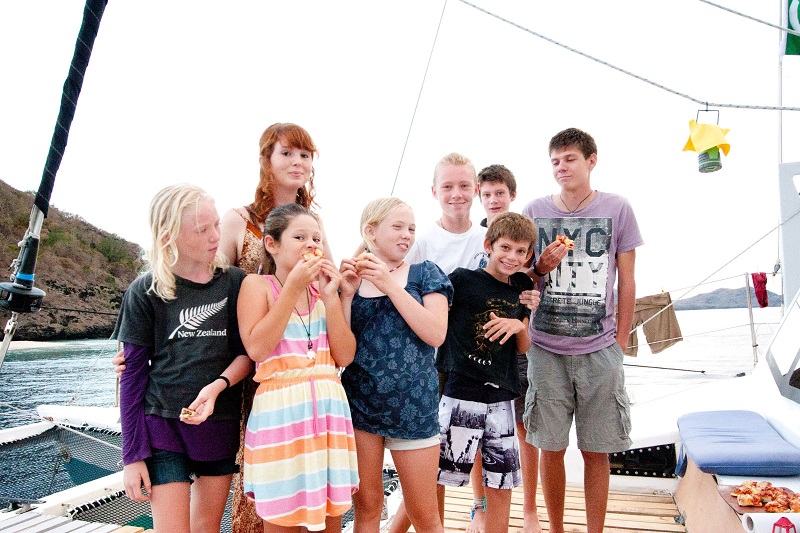 Maia with her boat friends After every barbecue, my mum would come up to me. "So-and-so wants to know if you and [let's call him J] have gotten together yet!" she'd giggle. The next day, "I was talking to such-and-such and she heard from so-and-so that you and J were walking on the beach together! Do you like him?" She wasn't being a "concerned parent" — she was just nosy. I had to tell my mum in no uncertain terms to leave me the hell alone. Relationships are difficult enough without having twenty adults hanging on your every move! Some of the stuff I do with my friends might seem surprisingly normal. I was taught to play Halo by the group of boys who needed another player. I was awful at it, but they didn't care. It seems funny to some people that we spend a lot of time inside playing video games, when we're basically in tropical paradise. But I burn red, and it was hot out, so we played Halo and got to know each other through rude jokes and popcorn fights. 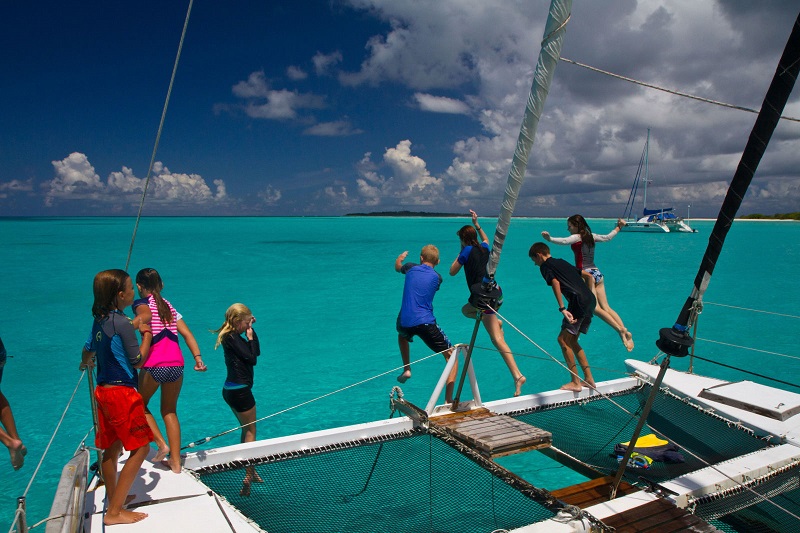 Kids from a variety of boats play on Ceilydh in the Maldives THE FIRST THING YOU NOTICE ABOUT A NEW PLACE Strange as it may sound, the smell of a place is often the first hint of it you get when you're at sea. Every place has its own scent. Sri Lanka was freshly brewed black tea, spicy curry, and the raw natural smell of silk. Soon we could see low mountains, vibrantly green in the sun. I loved Sri Lanka. It's often referred to as a more genteel India, with the same lush exotic beauty. We did some inland travel there, staying in small B&B's with crisp mountain air and eating spicy rotis and samosas for breakfast. 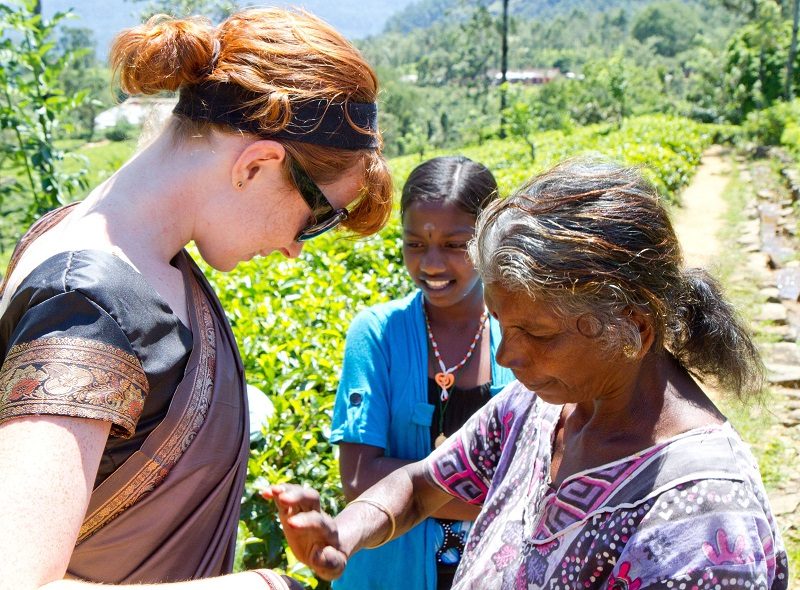 Maia is shown how to properly tie her sari at a tea plantation in Sri Lanka SURVIVING STORMS AT SEA The Indian Ocean crossing was more challenging than any ocean we'd sailed before. Getting older meant that I was more aware of the dangers and the weather. I'd take watches while my parents slept, watching for squalls and storms that approached. I'd learned to tell by the wind direction whether a rain cloud would hit us or pass us by, and I realized that this can be a dangerous lifestyle. I'd always known, of course, that if I fall in the water I could drown, or if the boat sank we could die, but I really understood it on the Indian Ocean crossing.  Face to face with a lemur in Madagascar Despite the challenges, I do have some wonderful memories from that voyage: Lying out on deck with a pile of friends, watching movies under the stars, warm breezes floating over us; Scuba diving in the Maldives; Making friends with Sri Lankan women, and learning how to tie my sari; Cackling with my friends on sleepovers, arms around each other as we laughed helplessly at a joke that probably wasn't all that funny. 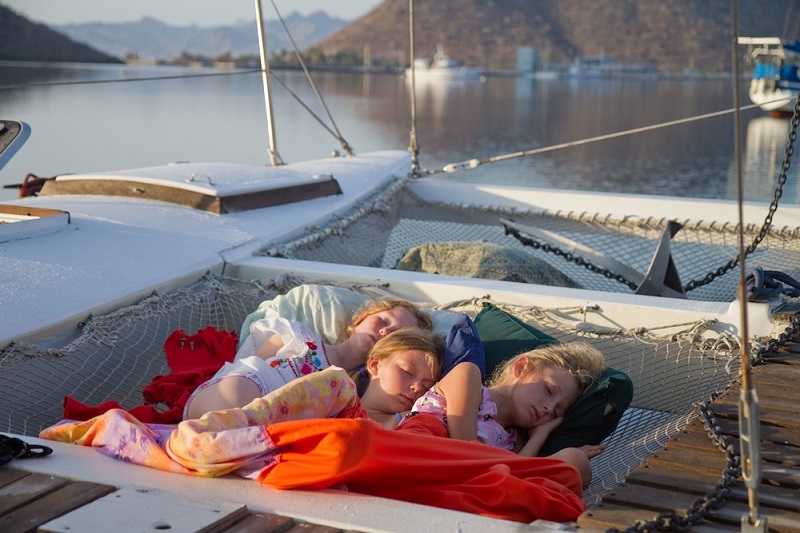 A boat sleepover 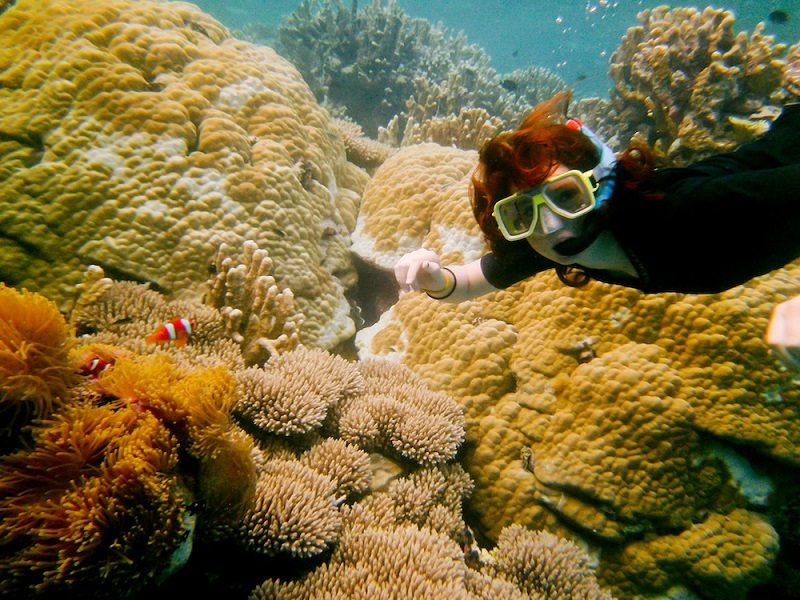 One of Maia's many snorkeling adventures VISITING THE MOST SECRET PLACE IN THE WORLD St Helena is a tiny, remote island in the middle of the Atlantic. You can only get there by ship, and fresh food is a luxury. It's also magical. It rises from the sea, a black forbidding rock that puts you in mind of some of the castles from Game of Thrones. I had an urge to watch the sky for dragons. It seemed impossible that anyone lived there. 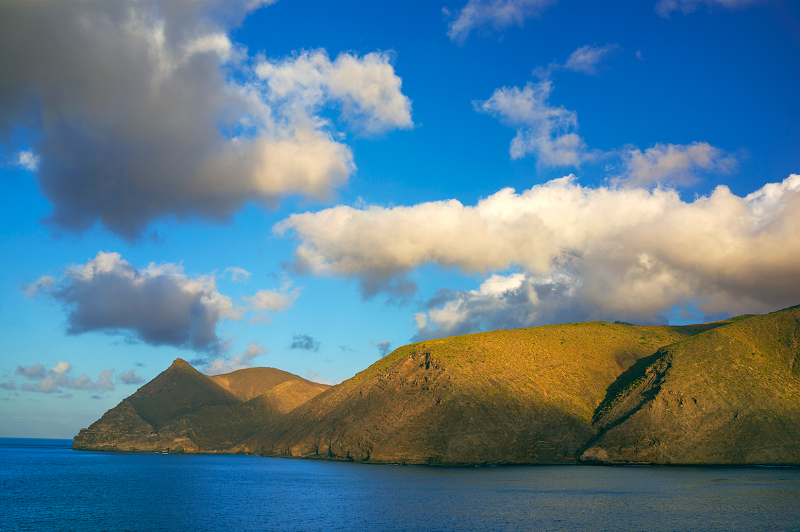 St Helena is one of the most remote islands in the world We soon learned differently. The interior of St Helena is lush and pastoral, reminiscent of the English country-side. There are even sheep. The locals (Saints, as they call themselves) are friendly individuals, but difficult to understand. Their accent turns "wash" into "wish" and they speak very fast. There are also British expats that have lived there for generations. It's weird, wacky, and wonderful. While there, we befriended an ex-governor's daughter, and a small film crew that were making a documentary about the island. We spent our days hiking, visiting Napoleon's tomb, and walking donkeys at the local donkey sanctuary. We had planned to spend two weeks and stayed six. We left on St Helena Day, when most of the island had congregated in the main town of Jamestown and were partying in the streets. Large, elaborately constructed floats snaked through the narrow streets, and we moved with them, back to the wharf where our dinghy was. We left with fireworks exploding behind us. 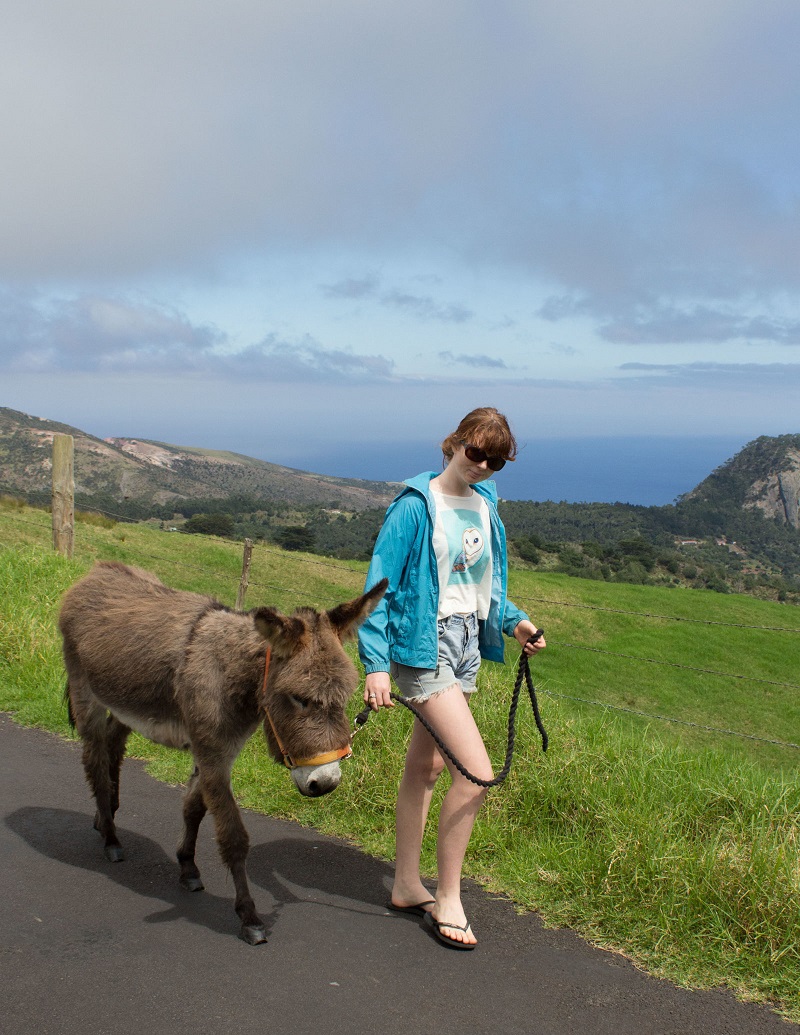 Maia walks a donkey at the St Helena donkey home MY JOURNEY IS ALMOST OVER Soon enough, I'll be back home, going to normal school and making normal friends. I'll live in an apartment, maybe go to the mall on weekends and get a part time job. My weird life — where I've seen amazing things, met incredibly interesting people, and learned a lot about myself — will be done. 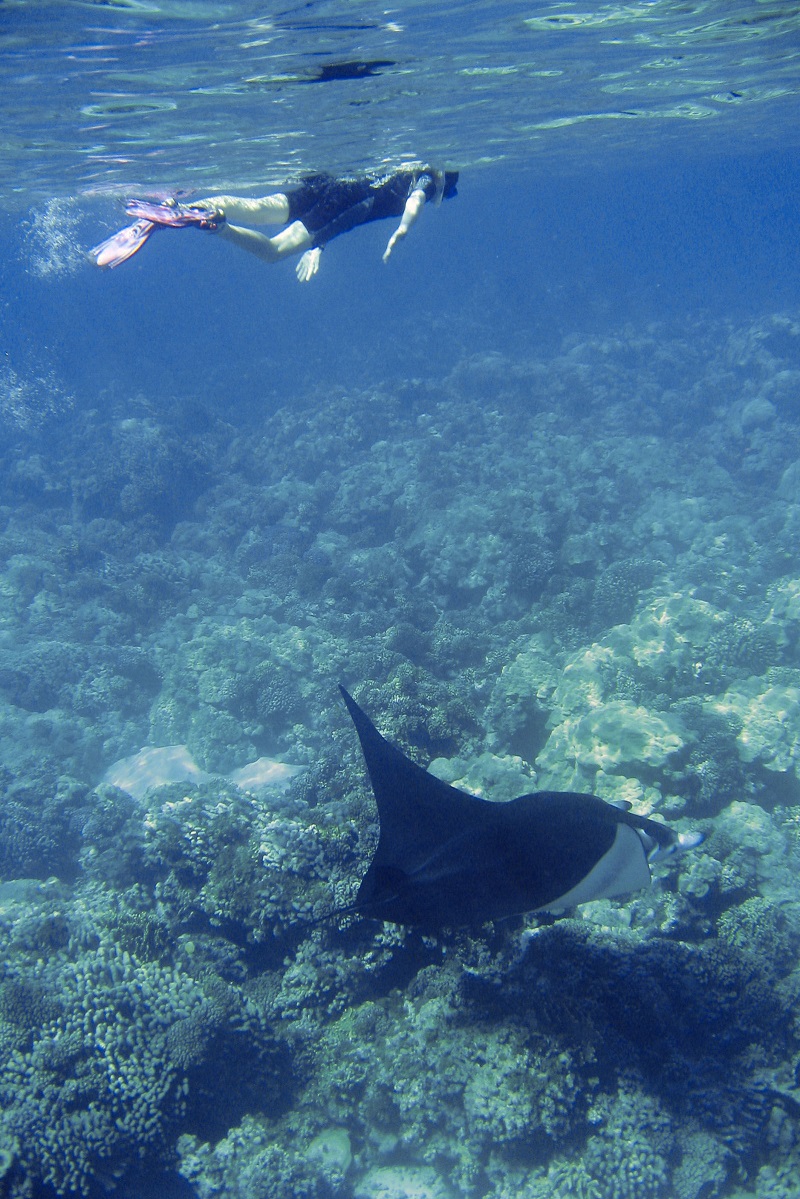 Snorkeling with a manta ray Sometimes, what I want more than anything else is to have a regular life. Other days, I look out my window at my constantly changing back yard, or climb out my window to lie on deck and look at the stars and I feel like I'm in exactly the right place. 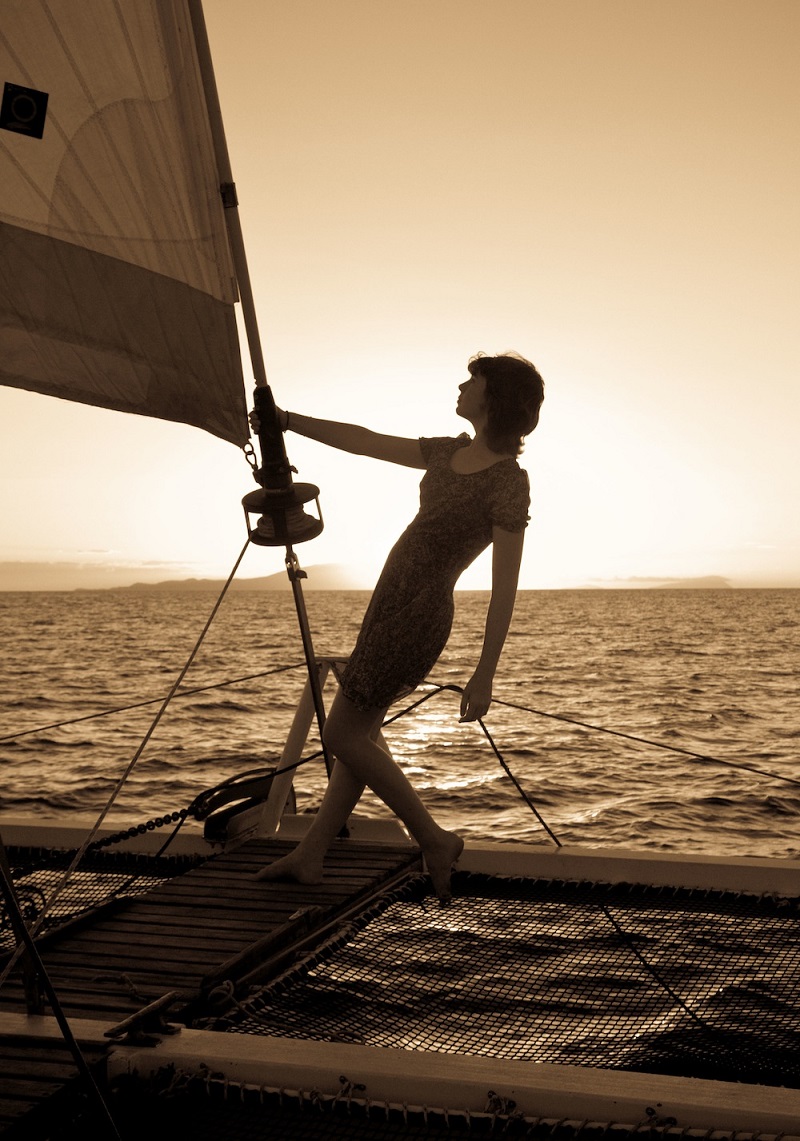 BY MAIA SELKIRK 2434
Your topic / Stockholm archipelago: Sailing Sweden’s pocket wilderness« : 13.10.2016, 01:05:33 »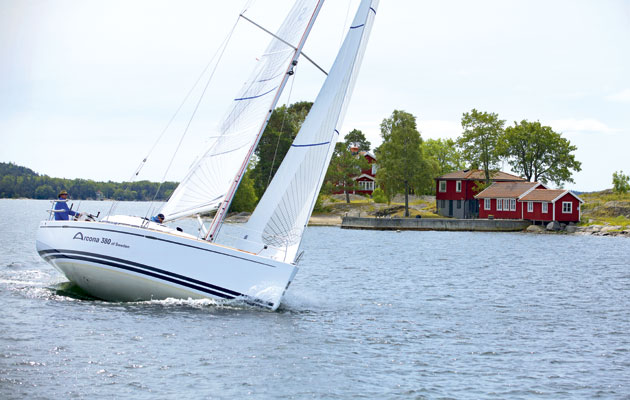 After just a couple of days cruising in the extensive Stockholm archipelago, Chris Beeson discovers why Swedish sailors rarely make it out of the Baltic. I’ve been lucky enough to sail in many places around the world and it has occurred to me that, among the many nations represented afloat, Sweden is seldom present. How can this be? Historically they are bold seafarers and fearless adventurers. Can the North Sea be such an insuperable barrier for these marauding mariners? The answer is no. It is simply that Sweden’s coastal waters, and their super-abundant islands, are so endlessly beguiling that there is simply no need for the Swede to sail anywhere else. Everything the adventurous cruiser could possibly want is scattered just a few miles off the Swedish coast. 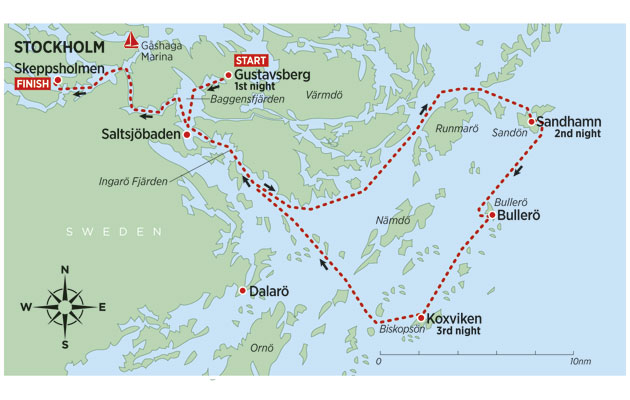 Our three-day route around Stockholms Skärgård The Stockholms Skärgård, or Stockholm archipelago, for instance, is a delicious chocolate box of 30,000 alluring granite islands, each with its own character, history and wildlife. It forms the central section of a larger archipelago of over 100,000 islands – the world’s largest. Summer temperatures can hit the mid-to-high 20s Celsius and the weather is familiar, being dictated, like our own, by the Azores High. In summer there’s a 25 per cent chance of winds reaching Force 5 but the water stays invitingly flat and you’re never far from a lee. Tides are all but non-existent due to the Baltic’s narrow entrance. What flow there is runs outward and is brackish, due to meltwater run-off further north. At greater depths, salt water flows in from the North Sea. It’s no surprise in a granite archipelago that rocks abound and their location was once privy only to fishermen and ferry captains. Indeed it has taken the introduction of GPS to open up the Skärgård to the great majority of Swedes. Most rocks are well charted, so stay zoomed in on your plotter and you should be fine. Don’t take any risks, though, as sea level can vary by as much as a metre between atmospheric pressure extremes. Storm surges can double that. 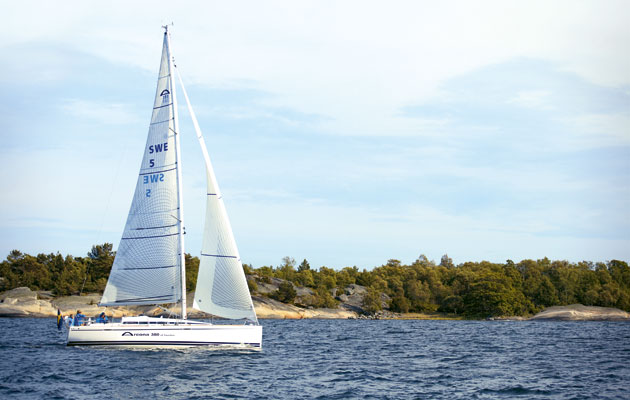 Deceent breezes, flat water and pleasant temperatures make for a sailor’s paradise The islands of the inner Skärgård, those closest to the mainland, are much bigger, higher, fertile enough to sustain thick forest and often ringed by Stockholmers’ summerhouses. The outer Skärgård has a more exposed, rugged feel. Islands are smaller and lower lying. The scalping of ice ages has left a mere skim of soil, allowing only the hardiest of perennials to take root. Some sport the odd red summerhouse or communal sauna but many appear to be virgin territory. The Skärgård is usually entered via Sandhamn in the east, Söderarm in the north or Dalarö in the south, but its limits are the lighthouse on Svenska Högarna, at the archipelago’s eastern edge, which is a mere 45 miles from the centre of Stockholm, and Arholma in the north, around 80 miles from Landsort in the south. It’s an enchanting pocket wilderness, less than a daysail wide, but you could cruise here all your life – as many do – and never land on the same island twice. We joined our boat, an Arcona 380, at Arcona HQ in Gustavsberg on the island of Värmdö, about 12 miles east of Stockholm city centre. After Torgny and Ewa Jansson, our hosts and guides, had stowed the victuals, we motored west out of Gustavsberg’s narrow entrance into the wider Baggensfjärden. Gusts eddied as we hoisted the mainsail. Low-lying, portentous ‘pancakes’ of granite slipped by to port as we unfurled the jib and ran south before an unseasonal squall. The Swedes had a pretty duff mid-summer in 2014: stiff northerlies dropped the temperature by half to 11ºC. We could just make out the Royal Swedish Yacht Club’s (KSSS) opulent clubhouse in Saltsjöbaden as we glided by. Reaching southeast into Ingarö Fjärden, Stockholmers’ summerhouses draped the steep coast of the island of Ingarö to port, peeping out from the dense woodland. These vary from masterpieces of modern architecture, each with a steep staircase running down to a small dock, complete with bobbing boat and sauna, to characteristic white-gabled, clapboard bothies, stained a rusty red by traditional falu paint made from copper and iron oxide from mine spoils. 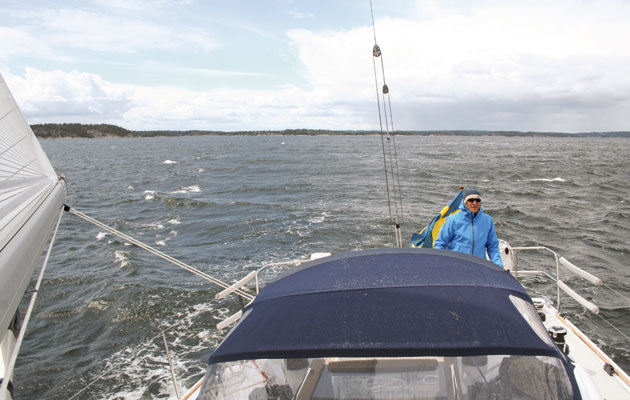 Arcona boss, and our guide to the archipelago, Torgny Jansson helms down Ingarö Fjärden In Nämdöfjärden, we tucked in two reefs and beat north-east into Force 5 winds, gusting Force 8 between the islands on our port-hand side. We bore off between Hasselö and Skarprunmaren through a narrowing channel towards the well-sheltered gästhamn (guest harbour) of Sandhamn on the island of Sandön, where we moored bows-to the quay. 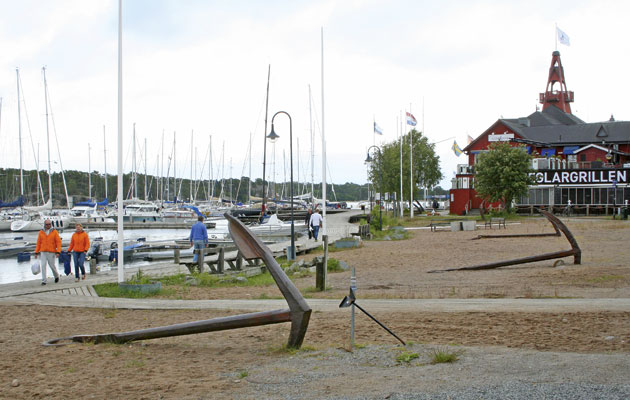 The Royal Swedish Yacht Club’s impressive offshore clubhouse dominates Sandhamn’s boardwalked harbour Sandhamn is the Cowes of the Baltic. We were there in late June, one of perhaps 30 visiting boats. By July, when Sweden closes for its ‘industrial holiday’, Sandhamn would be one big party with revelers tumbling off the ferries that service the islands like water taxis. Its tree-lined arc embraces 240 berths with faded grey timber boardwalks, dominated by the imposing offshore clubhouse of the KSSS, which was built in 1897. Electricity and water are available, fuel too. There’s a bakery, several restaurants, a general store and a bar on the waterfront. Dinky summerhouses abound but most of the locals live a little way inland among the winding, narrow, picket-fenced lanes. 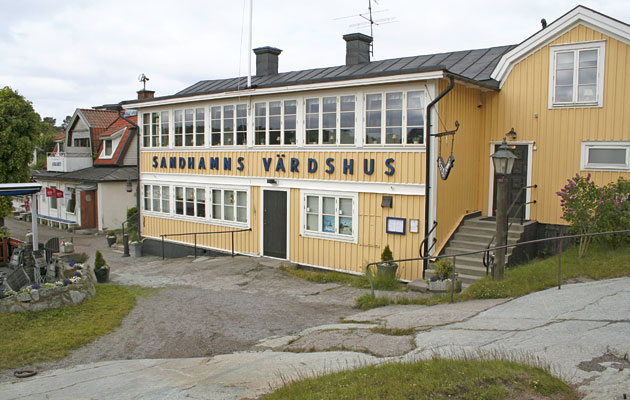 Sandhamn’s Värdshus, the archipelago’s foremost eatery, has fed seafarers since 1672 The rain and wind faded with the evening light and we awoke to a much brighter prospect. After a quick explore ashore we had breakfast on board and slipped the bow lines as Torgny hauled us out gently on the dropline. Clear of Sandön, we headed south-southwest and had a glorious 8-9 knot reach between bare pillows of granite that provide both shelter from the open sea and a reminder of their keel-crippling cousins beneath the surface. The 10-mile passage southwest to the island of Bullerö was soon clipped off and, after threading a course through the narrow fairway, we flipped on the engine and dropped sail in the lee of the island. While Ewa readied the lines and fitted the boarding ladder, Torgny explored the anchorage under engine and noted anchor points in the rock. Having decided where to moor, he motored 3-4 boatlengths off, hauled the 10kg Bruce out of the starboard quarter locker and threw it over the side onto the muddy bottom. The rope paid out round the mainsheet winch as we slowly closed the rocks, Torgny handed the helm to Ewa and went forward to jump ashore. 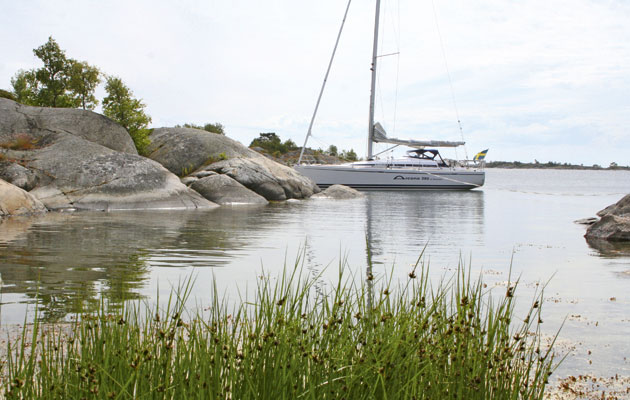 Moored bow-to the magical island of Bullerö, a jewel of the outer Skärgård Torgny made fast the windward line first, then they both adjusted kedge and bow lines to a distance off that was safe for both the crew and the plumb-bowed boat’s knuckle. To thwart gusts on the beam Torgny fished out a 50-metre webbing line, of the type usually kept on reels, wandered across to a rock off the windward beam, threaded the webbing through another anchor point and secured both ends to the port midships cleat. With four-point security, we felt able to explore the island. Bullerö is ‘marine deciduous forest’, a designation unique to this and the Åland archipelago. It was permanently settled by 1653 by crofting families who grew tubers and root crops, hauled wooden ploughs themselves as they couldn’t feed horses over winter, caught fish and shot seals and sea birds. However, mainland industries offered an easier existence and by the early 20th Century the islands were abandoned.  Tucked up in the lee of Bullerö with two bow lines, a breast line and a stern anchor In 1908, the renowned Swedish wildlife painter Bruno Liljefors bought Bullerö Island and 300 around it, and built a hunting lodge and several studios. In 1923, Liljefors sold the archipelago to his friend, newspaper magnate and keen sailor Torsten Krüger, who added a further 600 islands to the estate. He was an impresario and Hollywood stars such as Charlie Chaplin, Errol Flynn and Mary Pickford stayed on Bullerö. Krüger’s story is a rags-and-riches rollercoaster, but too spectacular to explore here. 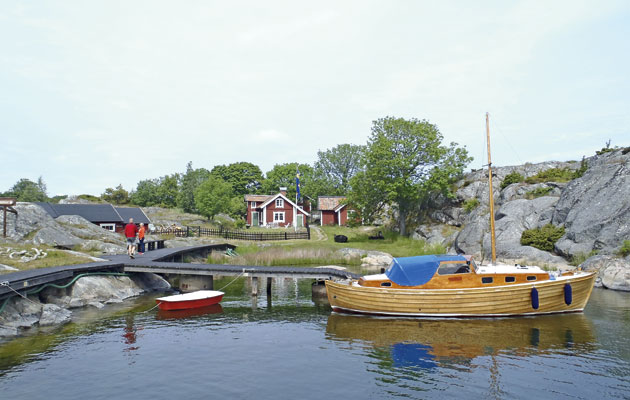 The port of Hemviken on Bullerö is ‘downtown’ with five buildings, including a youth hostel Krüger’s son Björn, an ardent naturalist, railed against the plundering of birds’ eggs, then still a common source of food. He bred rare sea eagles and eagle owls, protected indigenous species and essentially turned the island into a nature reserve. When, in 1967, Krüger decided to sell, Shell offered him SEK80m (£5.5m) but instead he sold all 900 islands to the Swedish state for SEK3.8m (£260k) on condition that the islands were protected. In 1976 the reserve was established and parts of the archipelago are out of bounds between February and August to protect breeding bird colonies. 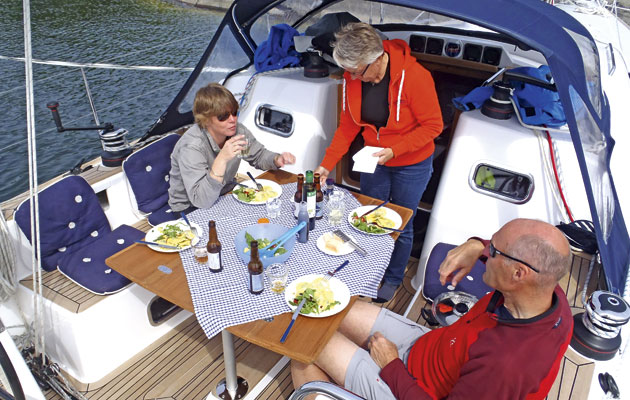 After exploring this tiny speck of heaven on foot, we sat down to lunch Author and artist Albert Engström, one of Liljefors’s cultural clique, mused on ‘a concentration of happiness in the untouched and sacred natural landscape’ of Bullerö and I know what he means. Perhaps that sense of protection explains the innocence I felt there. It’s a kingdom fit for a child, only a mile and a half from end to end, where small, rounded mountains overlook miniature meadows and Lilliputian forests fringe tiny bays, all ripe for exploration. I couldn’t stop smiling. 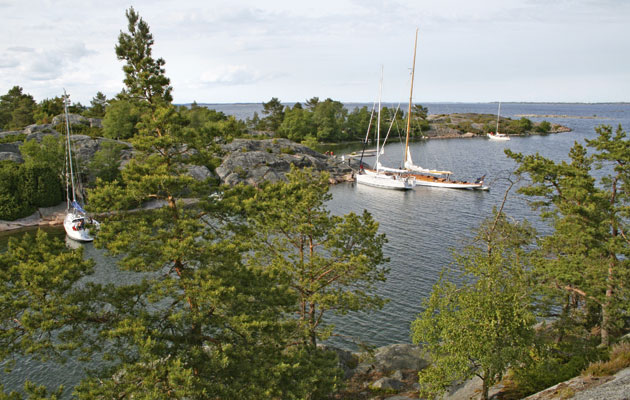 We followed the 150 Square Metre Skerry Cruiser Beatrice Aurore into the natural harbour of Koxviken on Biskopsön Back aboard, we continued our way south-west towards the natural harbour of Koxviken on Biskopsön until we spotted a rare and wonderful sight: Beatrice Aurore. She’s a Skerry Cruiser built in 1920 to the 150 Square Metre Rule devised in Stockholm in 1908. A few years ago, a crane crushed her during a botched launch. A syndicate of ten enthusiasts restored the 22-metre classic and she entertains her owners throughout the summer, each taking a week in turn. 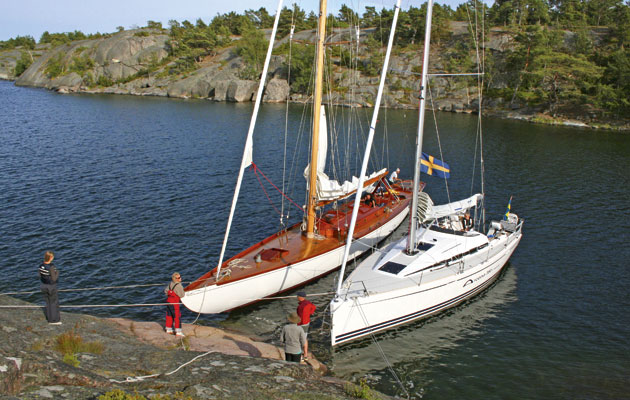 Any cruiser here needs a bag of bergskils, iron pegs that you can hammer into crevices to create mooring points We followed her into Koxviken on a clear transit. Once we’d chosen our spot, Torgny fished out the trusty Bruce and a bag of bergskils (like pitons, or iron pegs with loops that one hammers into crevices to create mooring points) while Ewa sorted out the bow. With the boat secure we had time to look around at the natural, sheltered beauty of our overnight mooring. 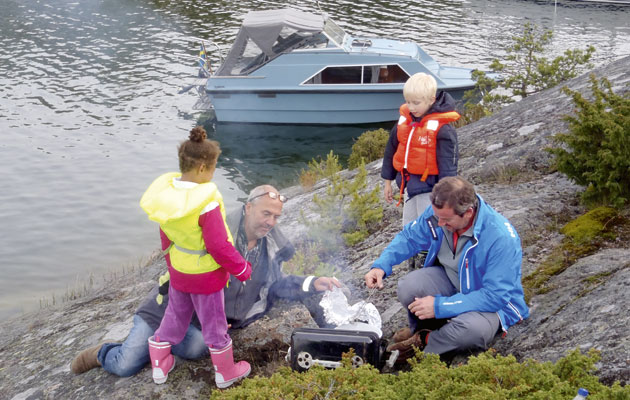 The hungry crew of Beatrice Aurore watch as Chris and photographer Stefan tend the grill After a brief ramble, during which I spotted none of the 50 fallow deer said to roam the island since their introduction in the 1920s, I returned to the boat for a Swedish grill. Food is prepped in the galley, cooked over charcoal ashore, then eaten on board. Food always tastes better when barbecued, better still in a wilderness. We ate and drank and watched the sun go down, and down, but night never fell. At midnight there was still enough light to read by. It’s another rare and wonderful pleasure, the ‘white night’. The following day, we knew, would end back in the UK but we’d seen enough to know that we’d return. After breakfast we re-rigged one bow line while Torgny knocked out the bergskils and we slipped away for a 30-mile passage, at the end of which Torgny said he’d drop us in town. With the wind still in the north, we beat back towards the inner Skärgård, back up the Ingarö Fjärden and past Saltsjöbaden. I expected we would enter Baggensfjärden and come alongside in Gustavsberg, then jump in the car. How wrong I was. 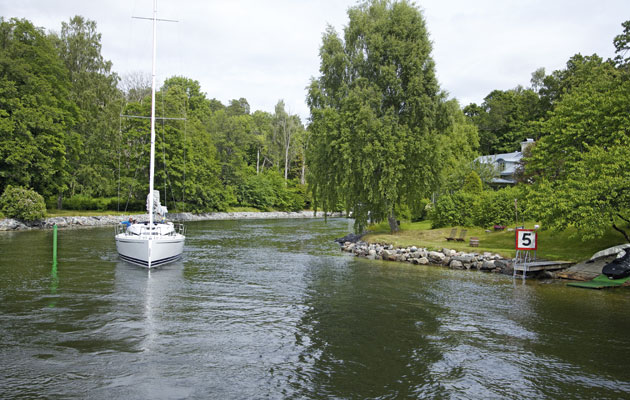 Motoring through the narrow Baggensstäket, the small boats’ shortcut into the centre of Stockholm We dropped sail and motored, I was concerned to note, straight for land. Soon there opened up a beautiful little inlet called Baggensstäket, lined with little summerhouses with astronomical price tags. Baggensstäket is a historic gateway into Stockholm: for trade; for plague, which arrived on a boat from Estonia in 1710; and for glory, with a famous Swedish victory over the Russians in 1719. 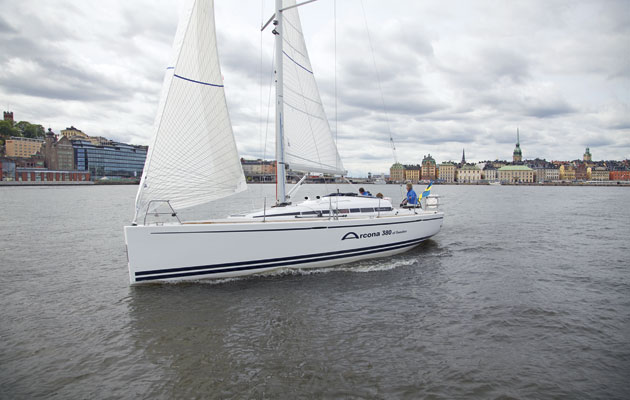 Sailing on the Norrström with Stockholm’s medieval centre, Gamla Stan, off the stern The narrow channel opened up into the Lännerstasundet before turning north up Skurusundet, a steep-sided gorge where chichi properties perched, each with its own dock and boatlift, to keep the boat out of the ice come winter. That opened up into the waterway used by cruise liners visiting Stockholm and lead east up the Norrström river to Gamla Stan, the medieval heart of Stockholm. Our final mooring was in the temporary marina built to house the fleet of the Round Gotland Race, directly opposite the Royal Palace and the Royal Swedish Opera House. ‘I said I’d drop you in town,’ said Torgny. This is why most Swedes see no need to wander far afield. Half a day earlier we were moored in a rock-strewn wilderness, teetering on the edge of civilization. Now we were right in the heart of a vibrant European capital. It occurred to me that the residents of Sweden have a remarkable playground on their doorstep, unmatched anywhere in the world: sheltered, stunning and seemingly endless. What’s more, they know it, love it, respect and protect it. I’m delighted that they also share it. Cruising Stockholm’s archipelago: what you need to know Graham and Fay Cattell, joint secretaries of the Cruising Association’s Baltic Section, have more than 17 years of local knowledge NB Correct at time of writing: 2014 Special equipment 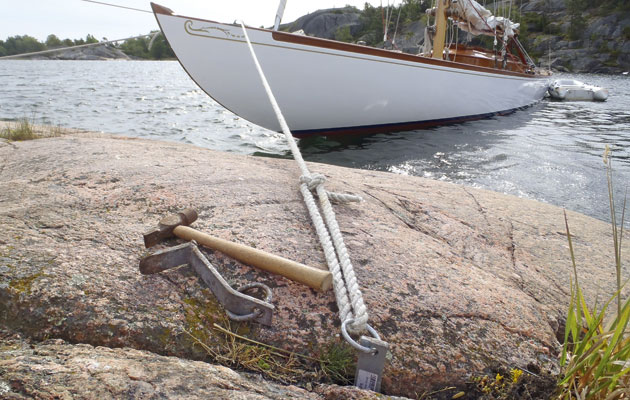 You’ll need a bag of bergskils to hammer into crevices Bow ladder (an open pulpit helps, as most boarding is over the bow) 50m webbing reel and a stern hook with spring lock Stern anchor and 30m warps (secure bow to trees or rocks) Bergskils (iron pegs that act as mooring points) Fender boards if transiting canals Small, portable BBQ (don’t light fires on rocks as they may crack) A courtesy flag flown from the starboard spreader Solar panels and a wind generator will keep batteries charged when you’re away from marinas Weather Prevailing winds move from the northerly quarter into the southwesterly quarter during the season. English language forecasts are broadcast at 0800 and 2000 LT on VHF. Choose channel by location: Väddö (ch78), Svenska Högarna (ch84), Nacka (ch26), Södertälje (ch66), Torö (ch24). Documentation Carry insurance documents, proof of VAT paid and any qualifications documents. Charter skippers need an RYA Yachtmaster or ICC ticket. Berthing 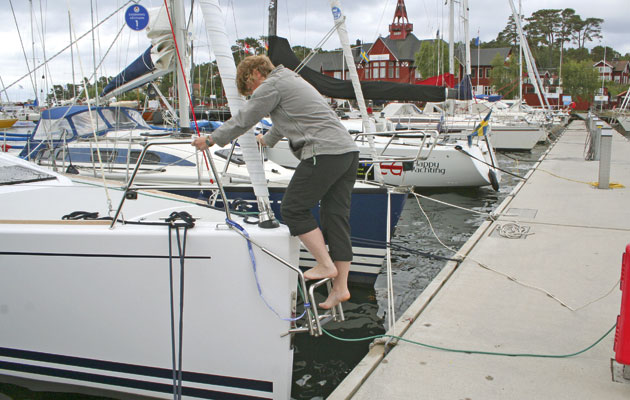 Most of the mooring is bow-to, so a bow ladder and an open pulpit helps Costs are generally less than the UK’s south coast. Yacht club harbours are cheaper and usually have guest berths – look for the Gästhamn signs. Facilities vary but expect water, electricity, toilets, recycling, bins and often a bastu (sauna). Anchoring Sweden’s right of public access (allemansrätt) means you can anchor anywhere, but don’t anchor close to houses, to respect their privacy. Pilotage 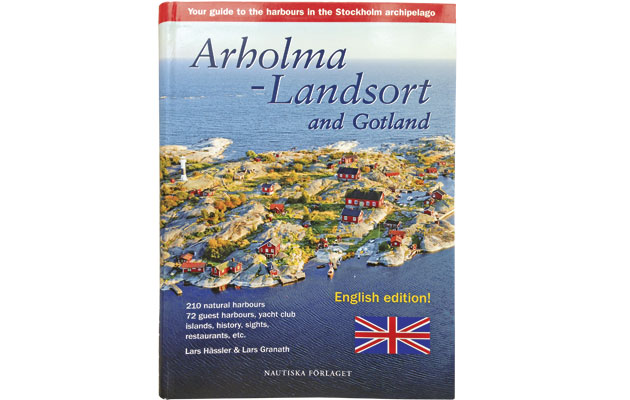 This is the best pilot book by far, but it’s out-of-print with no plans to reprint. Find a second-hand one, or learn Swedish Buy folio charts locally or order for UK delivery. Follow the routes or ‘leads’ on the charts, marked with buoys, beacons and lighthouses. Use GPS as a back-up, but eyeball navigation is essential and you must regularly update your position on the chart. The best pilot guide, the English language version of Arholma-Landsort and Gotland, is out of print with no plans to republish. Look for a second-hand copy. Waste disposal Foreign-flagged vessels don’t need a holding tank but after April 2015 discharging sewage in Swedish waters will be illegal. Currently, discharge is not permitted in harbours, lakes or canals. More pump-out facilities are being installed, even in anchorages. Many islands have earth closets. Swedish Cruising Association For a season in Sweden, membership of the Swedish Cruising Association (SXK, www.sxk.se) can be worthwhile (family membership SEK640, or £55). Members have access to SXK moorings and reduced rates in SXK harbours. Communications Telia network has the best cover in the archipelago. If you expect calls from Swedish friends, a local SIM will save them money. If only making calls, new roaming charges (from July 2014) make a local SIM less necessary. Wi-fi is available in many harbours. The UK 3 SIM works in Sweden for data-roaming and internet access. Fuel Diesel from fuel docks contains no biodiesel, unless the station also supplies road users. Camping Gaz bottles can be exchanged in some places but bring a good supply from Germany or Denmark, or invest in a Swedish gas bottle, which can be exchanged anywhere in Sweden only. It’s possible to refill a Calor bottle with the right adaptor. Alcohol Beer at 3.5% ABV or below is sold in shops. Anything stronger means a visit to the state shops (Systembolaget). Spirits are expensive but good wine is comparable to the cost in UK supermarkets. If you’re passing through Germany, it’s worth stocking up there. Medical Mosquitoes can be a problem, so take your insect repellent or buy locally. If possible fit fly screens to hatches or take netting with you. Ticks may carry TBE (tick-borne encephalitis) or Lyme disease. Routes to the Baltic From southern England, cross the North Sea or coast-hop to Brunsbüttel in Germany, then transit the Kiel Canal. From the northern UK, head for the Skagerrak and Kattegat. Some boats may transit the Limfjord but beware Denmark’s shoal, lee shore hazards. If you’re heading directly for the Stockholm archipelago, you can transit the Thomas Telford-engineered Göta canal. There are two canals (Trollhätte and Göta) plus stretches of river and the huge lakes. The transit fee – SEK6,510 (about £560) one way for 9-12m (30-39ft) yachts, with a SEK500 (£43) surcharge for beams over 3.3m (10ft 10in). This includes up to five nights in 21 marinas on the route. Chartering Flights take around 2½ hours and return tickets start from £150. There are charter fleets, or companies chartering private owners’ boats. Search online for ‘bareboat yacht charter Stockholm’. Chris Beeson 2435
Your topic / Dynamiq Yachts Melges 20 Monaco Winter Series: Day 1« : 09.10.2016, 00:17:51 » The fourth season of the Melges 20 Winter Series started October 7th at one of the most amazing venues: the yacht club of Monaco. The participating teams of Act 1, the Jefferson Capital Cup, are from France, Italy, Monaco, Poland and Russia. Naturally, as per usual the major part of the fleet is Russian. Three races were planned for the first day of the regatta, but due to the light wind, only one took place. However, the race was incredibly intense and as eventful as three races combined. Dynamiq Yachts It was almost impossible to predict the winner; there were several leading teams. PIRogovo (Alexander Ezhkov), Pirogovo Evolution (Leonid Altukhov), Alex Team (Alexander Mikhaylik), Victor (Alexander Novoselov), Nika (Vladmir Prosikhin), and Leviathan (Vadim Yakhinson): all of them were leaders of the fleet at some point. And so was the team of Pavel Grachev, who had their debut today! The winner of the Winter Series 2015/2016, Alexandr Ezhkov, had very mixed success, and so did Prosikhin and Yakhinson. They all have been in both the very bottom of the rankings and at the top throughout the race. The shifting winds played their part today as well. The top three teams were PIRogovo, Leviathan and Nika. The season has started, and we are looking forward to tomorrow’s continuation of this battle. The races start at 11.00 am (CEST). There are three or four races planned for the day. Results 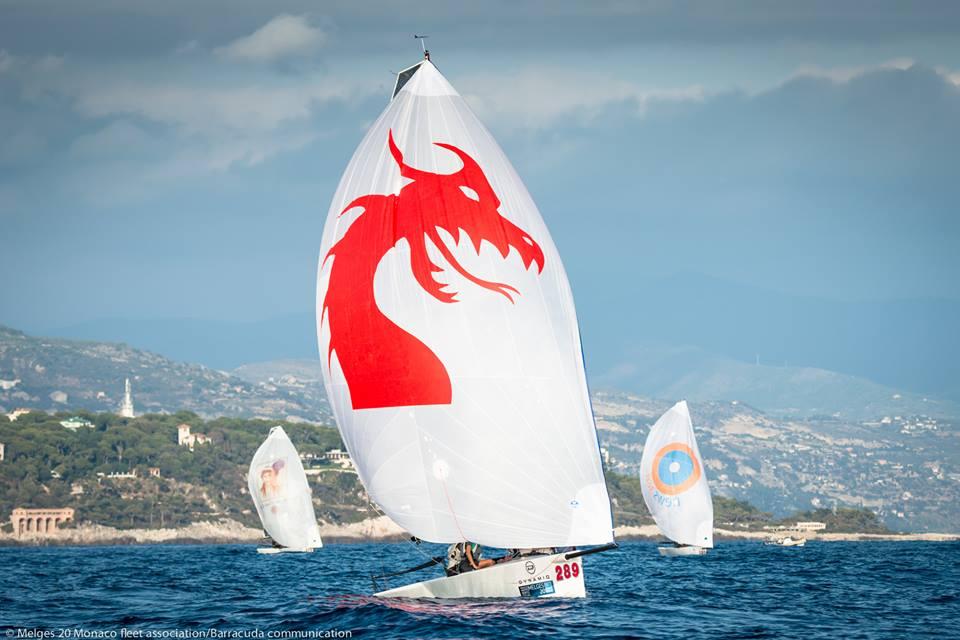 This Series was created as a competition for Russian sailing crews, but now it turned into an event of European scale. This 2016/2017 season is the fourth of the Melges 20 Monaco Winter Series and it has become the main mid-season competition of the year. Last year, the competition ended on March 20th and we have to admit it had never been that tense before. There were 5 different winners of 5 regattas (Nika from St. Petersburg Yacht Club, PIRogovo from Moscow Yacht club, the host yacht Out of Reach, Russian Anna and Swiss Section 16), and as we know, sometimes even the last race can change up the rankings and determine the winner. In the 2015/2016 season the overall standings were lead by Russians. Alexander Ezhkov and his crew, Daniil Odintsov and Alexander Ekimov, were leading the fleet from the very beginning and achieved their deserved victory. Russian Bogatyrs (Igor Rytov, Konstantin Besputin and Anton Sergeev) reached second place at the last moment. Nika of Vladimir Prosikhin was placed 3rd. There are also quite a few outstanding sailing crews, who were in the top 10 yachts on the competition. It includes Valentin Zavadnikov, who is the inspiration behind this whole Winter Series idea. It also includes Dmitriy Samokhin, Maxim Titarenko, Vadim Yahinson, Alexander Mikhaylik and Anatoliy Karachinskiy. Among the top 20 yachts there are two more Russian sailors: Oleg Evdokimenko and Alexandr Novoselov. It would be a mistake to think that only Russians were in the lead last season in Monaco. Guido Miani and his Out Of Reach were extremely close to the 2nd place. They won one regatta, and in three regattas they were more than confident competitors, but they missed one of the Acts and it cost them possible victory. Manfredi Vianini Tolomei (Maolca) finished 6th in the overall rankings of the Series. Richard Davies’ Section 16, the star and winner of the last two Acts of the season 2015/2016, is places 15th in the overall rankings of the Series. Almost all participants of the Melges 20 Monaco Winter Series continued their battle during summer: the summer Sailing Series and the World Championship, which was held in Scarlino (Italy) and hosted 56 teams from all over the world. Some teams were lucky; some did not fully achieve their potential. Finally, after summer training and competitions teams are coming back to the famous Cote d'Azur! 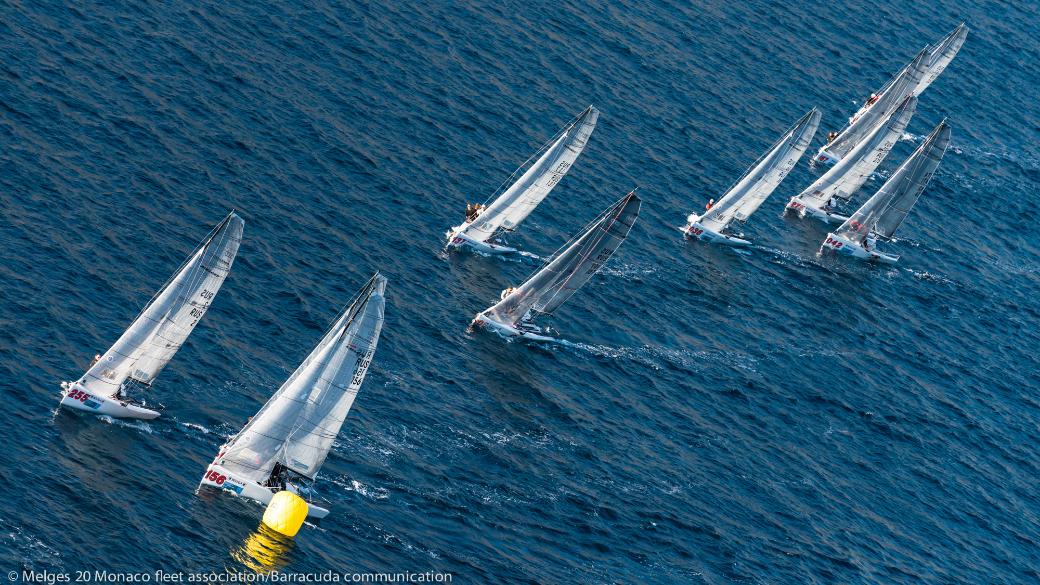 20 participating crews are expected from different countries. The winner of third season of Melges 20 Monaco Winter Series and Russian Open Championship, PIRogovo team, will also be there. Without any doubt, it is going to be an amazing season! The official partner of the Series is Dynamiq Yachts, and the partner of Act 1 is Jefferson Capital. The overall rankings of Monaco Melges 20 Winter Series 2015/2016 The 2016 Melges 20 World Championship results Via 2436
Регаты и Матч-рейсы / Старт Melges 20 Monaco Winter Series« : 09.10.2016, 00:04:11 » this topic in English  7 Октября на самой красивой площадке Европы, в яхт-клубе Монако, стартовала ставшая традиционной серия зимних регат класса Melges 20 В первом этапе - Jefferson Capital Cup - принимают участие команды Франции, Италии, Монако, Польши и России. Россияне по традиции составляют большую часть флота. В программе первого дня значились три гонки. Погода – слабый ветер – дала возможность провести лишь одну. Однако по накалу борьбы и количеству событий эта одна гонка стоит трех! Предсказать, кто выиграет было практически невозможно: лидерство переходило из рук в руки много раз. «ПИРогово» (Александр Ежков), Pirogovo Evolution (Леонид Алтухов), Alex Team (Александр Михайлик), Victor (Александр Новоселов), «Ника» (Владимир Просихин), «Левиафан» (Вадим Яхинсон) – все они успели полидировать. Как и команда дебютанта серии Павла Грачева – отличное начало! Победитель зимней серии прошлого сезона Александр Ежков шел в гонке с переменным успехом, как и Просихин, и Яхинсон – их то кидало вниз таблицы, то выносило на самый верх. Не последнюю роль в развитии событий, как водится, сыграл переменчивый по силе ветер. Тройка призеров гонки сформировалась в финишном отрезке: «ПИРогово», «Левиафан» и «Ника». Начало сезону положено. Ждем продолжения борьбы завтра. Старт гонок намечен на 11.00 (местное время). В соответствии с гоночной инструкцией возможно проведение трех-четырех стартов. Результаты  Задуманная как соревнование для российских поклонников парусного спорта, серия превратилась в мероприятие европейского масштаба. Сезон 2016/2017 – четвертым в истории Melges 20 Monaco Winter Series, которая за это время закрепилась для европейского флота этого класса в качестве главной в условиях межсезонья. Завершившийся 20 марта предыдущий розыгрыш был выдающимся по накалу борьбы. Достаточно сказать, что на его пяти регатах было пять победительниц ("Ника" Яхт-клуба Санкт-Петербурга, команда подмосковного яхт-клуба "ПИРогово", хозяйка марины Out of Reach, российская "Анна" и швейцарская Section16), а исход борьбы часто становится известен лишь в последней гонке. В сезоне 2015/2016 в общем зачете серии в лидерах были коллективы, представляющие Россию. Итоговую победу, причем, более чем заслуженно, одержал Александр Ежков. Он с бессменным экипажем - Данила Одинцов и Александр Екимов - возглавлял флот с самого старта сезона. Второе место на финише вырвали "Русские богатыри" - Игорь Рытов, Антон Сергеев и Константин Беспутин. Третьей стала "Ника" Владимира Просихина. В десятке лучших финишировали Дмитрий Самохин, вдохновитель зимних сезонов в Монако Валентин Завадников, Максим Титаренко, Вадим Яхинсон, Александр Михайлик и Анатолий Карачинский, в двадцатке – Олег Евдокименко и Александр Новоселов. Ошибкой было бы считать, что минувшей зимой в Монако блистали лишь российские команды. Очень близок к тройке призеров серии был Гвидо Миани и Out of Reach. Одну регату команда выиграла, в трех выступала более чем уверенно, но ее подвел пропуск одного из этапов. Maolca Манфреди Вьянини Толомеи финишировала по итогам серии шестой. Section 16 Ричарда Дэвиса в итоговом протоколе на 15-й позиции, но именно эта команда – звезда двух заключительных этапов прошлого сезона. Большинство участников Melges 20 Monaco Winter Series продолжили выяснять отношения и летом - в Sailing Series, на чемпионате мира, прошедшем в нынешнем году в Скарлино (Италия) и собравшем 56 команд. Кому-то сопутствовал успех, кто-то не реализовал все свои возможности. Итак. В марте мы расстались с флотом словами: «Натренировав мышцы во время летних регат, команды вернутся на зимовку на Лазурный берег». И они возвращаются!  На старте нового сезона организаторы ожидают около 20 экипажей из нескольких стран. Заявлена к участию и победительница третьего сезона Melges 20 Monaco Winter Series и августовского Russian Open "ПИРогово". Сомнений в том, что нас ждет увлекательный сезон, нет! Партнером нынешнего розыгрыша выступает компания Dynamiq Yachts, а первый его этап проходит при поддержке компании Jefferson Capital. Рейтинг зимнего сезона 2015/2016 Рейтинг Чемпионата Мира 2016 в классе Melges 20 Источник 2437
Машинный телеграф / Re: Подруливающее устройство (bowthruster)« : 23.09.2016, 01:22:37 »
Видимо, считается все-таки не очень хорошей практикой, раз в маринах запрещают
 При слабом ветре проблем нет особых - всегда можно вовремя "скинуть" паруса. Можно найти отдельно стоящий понтон и потренироваться около него При слабом ветре проблем нет особых - всегда можно вовремя "скинуть" паруса. Можно найти отдельно стоящий понтон и потренироваться около него  Любые маленькие спортивные лодки, типа Este 24, Beneteau Platu 25, J-ки и SB-шки всегда швартуем под парусами 
2438
Машинный телеграф / Re: Подруливающее устройство (bowthruster)« : 22.09.2016, 01:16:46 »
Периодически практикуем
 Правда, на спортивных лодках. В марине движение под парусом запрещено, но мой инструктор для общего развития демонстрировал швартовку 43 футовой лодки к понтону при 15 узлах Правда, на спортивных лодках. В марине движение под парусом запрещено, но мой инструктор для общего развития демонстрировал швартовку 43 футовой лодки к понтону при 15 узлах
2439
Машинный телеграф / Re: Танцы двумя корпусами« : 12.09.2016, 23:27:08 »
Да мы тоже все собираемся потренироваться, но так пока и не выбрались. А нужно бы!
2440
Машинный телеграф / Re: Почему шкипер-одиночка Эрик Венобо может гоняться 58 часов без сна, другие — нет« : 12.09.2016, 23:25:26 »
"Простите, дурное воспитание!" (с)
 Не только можно, но и нужно! 2441
Машинный телеграф / Re: Почему шкипер-одиночка Эрик Венобо может гоняться 58 часов без сна, другие — нет« : 12.09.2016, 23:17:38 »
Спасибо, что читаете - очень приятно!
2442
Машинный телеграф / Re: Часы для яхтсменов« : 12.09.2016, 23:07:51 »
А если без шуток, то вот эти очень удобные:
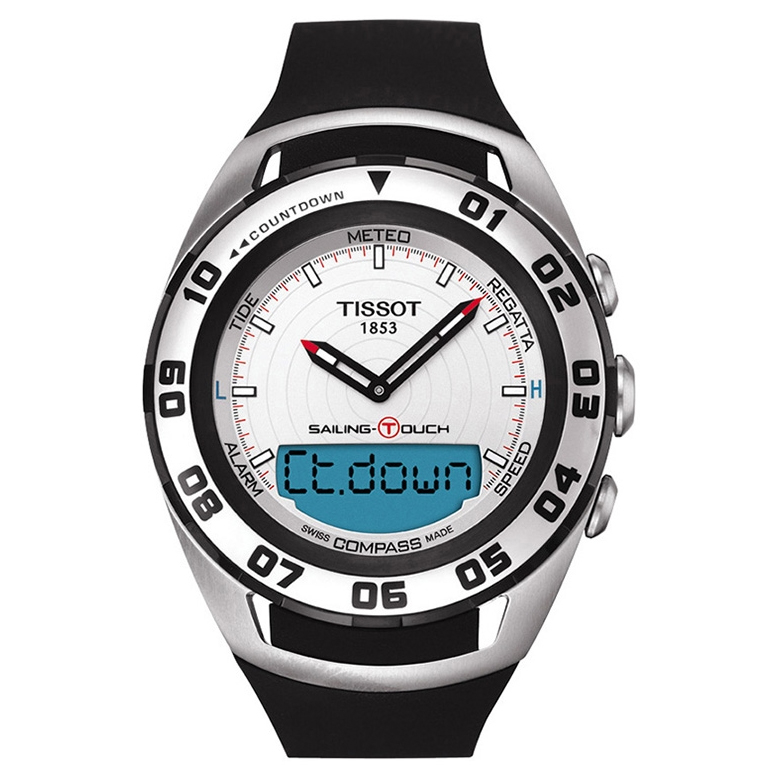
2443
Машинный телеграф / Re: Часы для яхтсменов« : 12.09.2016, 23:05:25 »
Тогда уж, вот так - чего уж там
 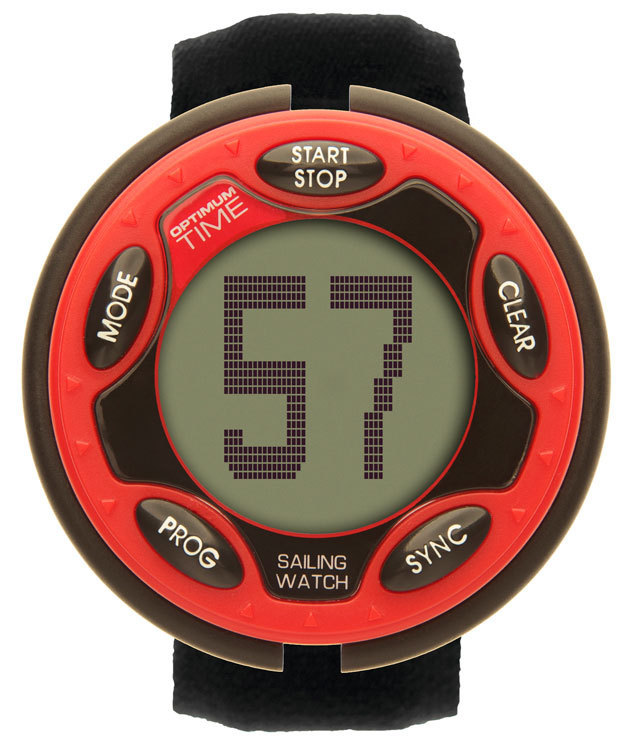
2444
Your topic / 9 everyday things a sailor will kick your ass at« : 12.09.2016, 22:58:28 » You’re winning at this life thing. You’re well-travelled. You have strong opinions on the meat industry and an arsenal of impressive life hacks you picked up while backpacking in Burma. You can open a wine bottle with your shoe and cut a sarong in half using just a cat. Your family thinks you’re great because you can make baklava from memory out of rain water. But there’s always someone out there that’s cooler than you. Like sailors. You’ll never be as cool as a sailor. I’m no sailor. I like napping under trees and letting my food go through the full digestive process too much to commit to a life on the ocean. But I did recently get the opportunity to hang out at sea with some of the boatmen and women competing in The Volvo Ocean Race (full story in the February 2015 issue of Getaway). These are not your average yachties. These are hardened seafarers who are on the ocean come rain or shine, sailing around the world, eating freeze-dried sandpaper and chiselling salt off their forearms with live seagulls. At sea their talents are vital for survival. On land they might just be superhuman. Here are nine everyday things they’d kick your ass at without even trying. 1. Parallel parking 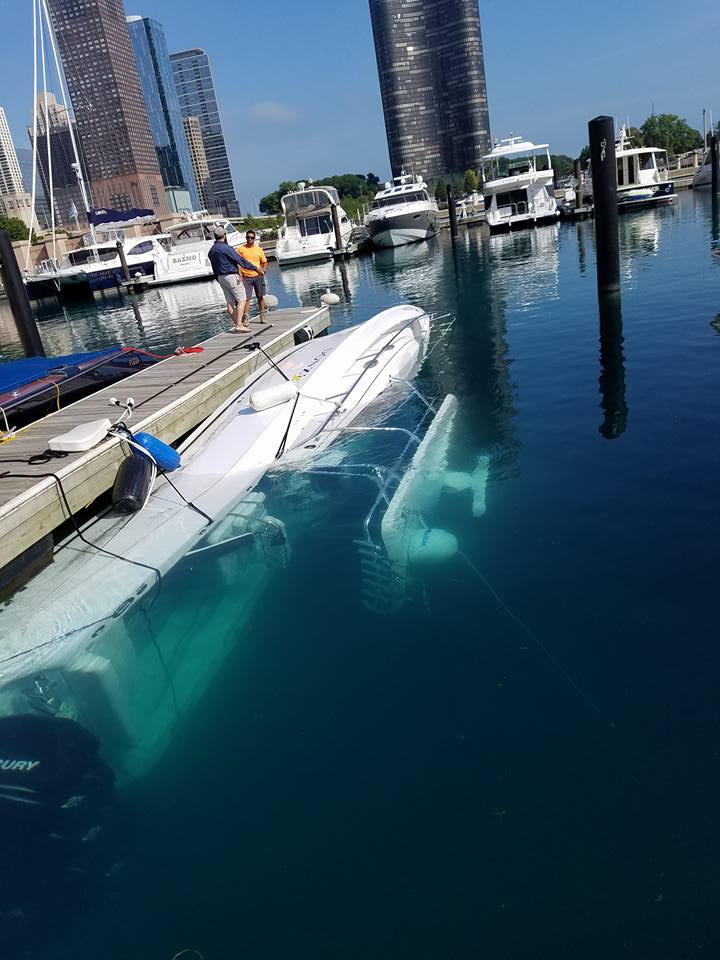 I know, I know. You’re great at parallel parking. You should be the president of it. The words three-point turn don’t even exist in your vocabulary. But you’re an amateur. Try backing a fire truck (without rearview mirrors) into a car wash, on ground made of water, during a thunderstorm. That’s what sailors do. They call it docking. 2. Walking straight when drunk 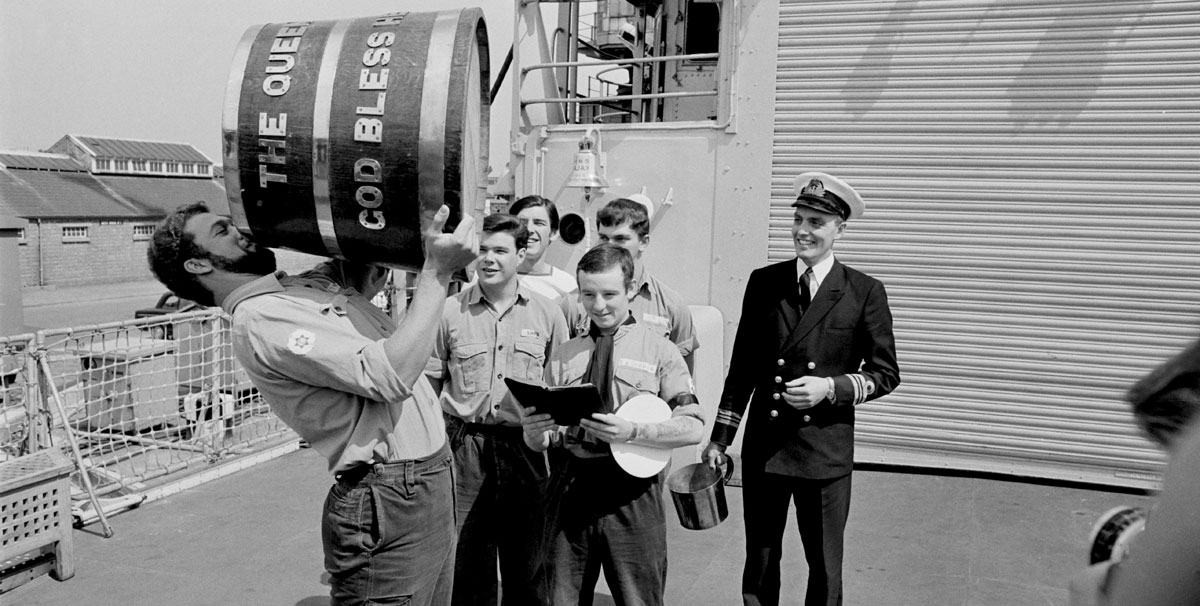 Your poker face is a farce. We all know how many tequilas you’ve had as soon as you see-saw to the bathroom like a sausage in a pinball machine. Legs don’t lie, unless you’re a sailor. A life on the water imbues sailors with a liquescent centre of gravity. The more fluid you put inside them, the straighter they walk. In fact, if you see a sailor off-kilter you should probably buy him a drink. 3. Straightfacing a double entendre  Sailing terminology is (wait for it) an ocean teeming with metaphors, puns, double entendres and that’s-what-she-saids. You can’t think of a boating pun that hasn’t been exhausted. Chuckling at words and phrases like ‘breastlines; cockpit; coming about; and, in need of a tug’ is the sole folly of us landlubbers. Find someone who can, without flinching, present a Seaman Discharge Book (yes, that’s an actual thing) to a customs official and you’ve found a sailor. 4. Giving directions  ‘Ja, so like take a right by the tree and then pass the school. I think it’s a school. Maybe it’s prison. A few blocks behind that is a road. I can’t remember the name of it but just call me when you’re outside.’ These are not directions. These are dangerous non sequiturs that cause people to remain seated in their own gaseous emissions longer than they should. If people gave better directions, there’d be a smaller hole in the ozone layer. Sailors know this (and they’re not even the ones using all the fuel). They also know that on the ocean vague directions can lead to death. Or worse, Port Elizabeth. 5. Dressing appropriately 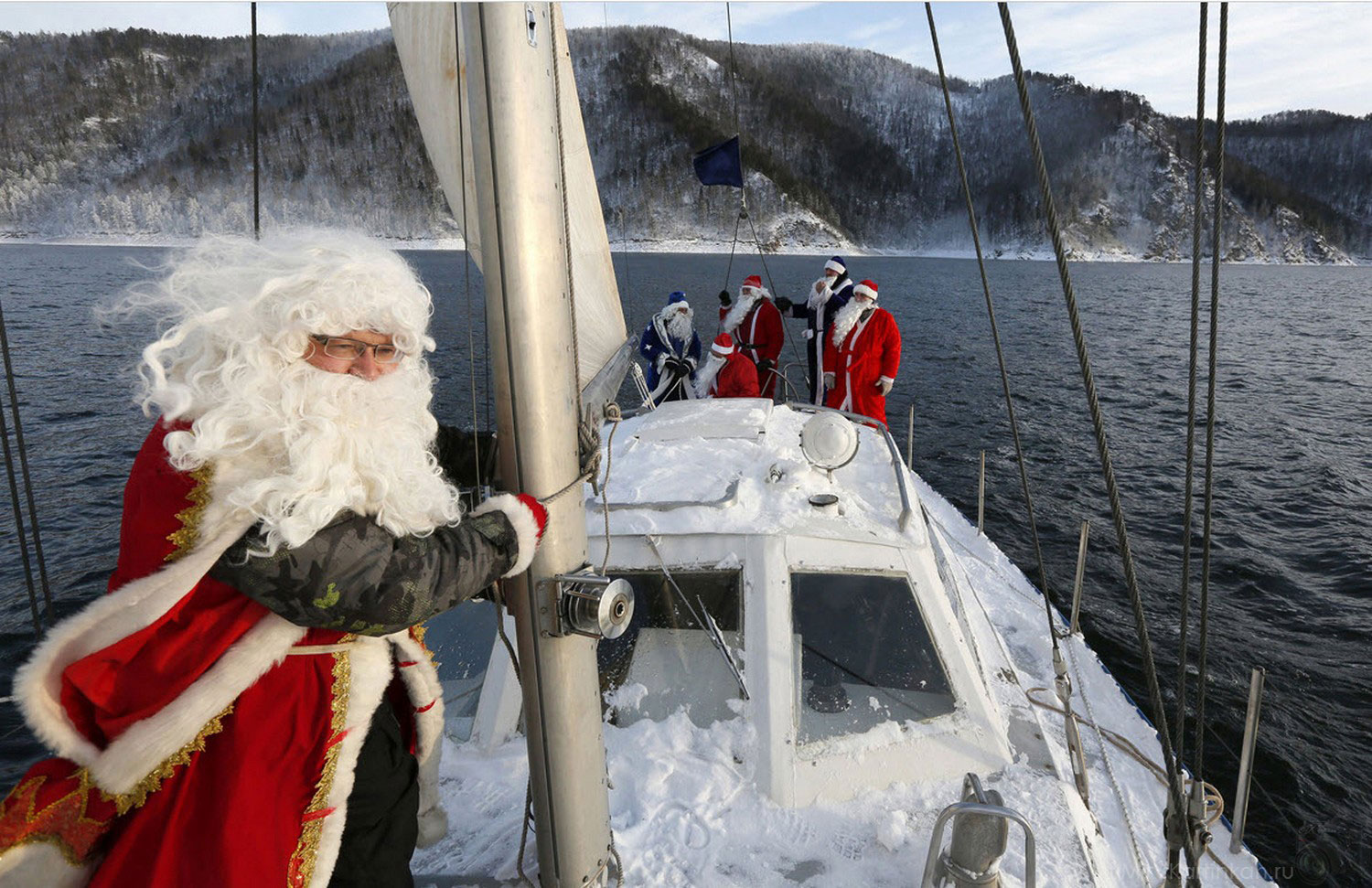 Weather app, shmeather app. Even the best ones resort to some measure of horoscopic hocus pocus and the problem is nobody has built one out of actual human bones. Sailors have bones. They have bones that tingle, crack, wobble and creak. Sailors can feel inclement weather in their bones before the weather even knows it’s feeling inclement. If you want to know what to wear for the day, find a sailor and copy what they’re wearing. Except epaulettes. Never wear the epaulettes. 6. BDSM 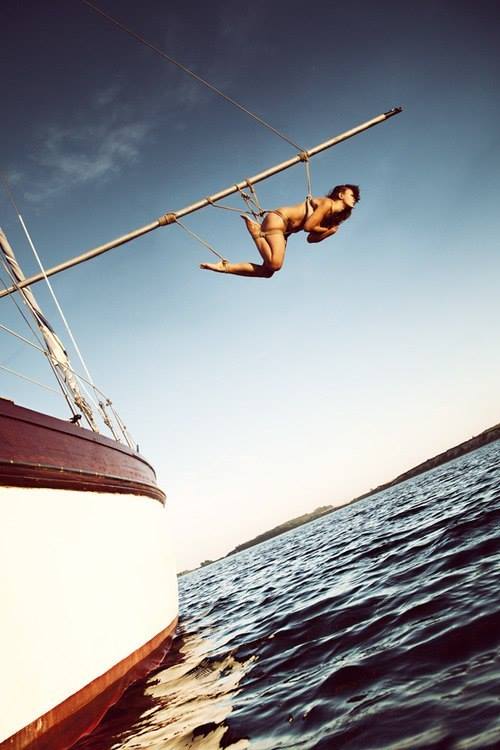 Don’t fib. The reason you’ve never been open to the idea of bondage isn’t because it’s taboo. It’s because you’re rubbish with ropes. Tying your beau to a bedpost isn’t the same as tying a shoelace. There are safety issues. A combination of poor ropemanship and a slippery surface can turn into an emergency very quickly and nobody wants to be gnawing on a granny knot next to a blue cadaver when the police arrive. You know who knows a thing or two about knots? Sailors. They could string up a wrestler with birthday ribbon. And, more importantly, untie him afterwards. 7. Pulling an all-nighter 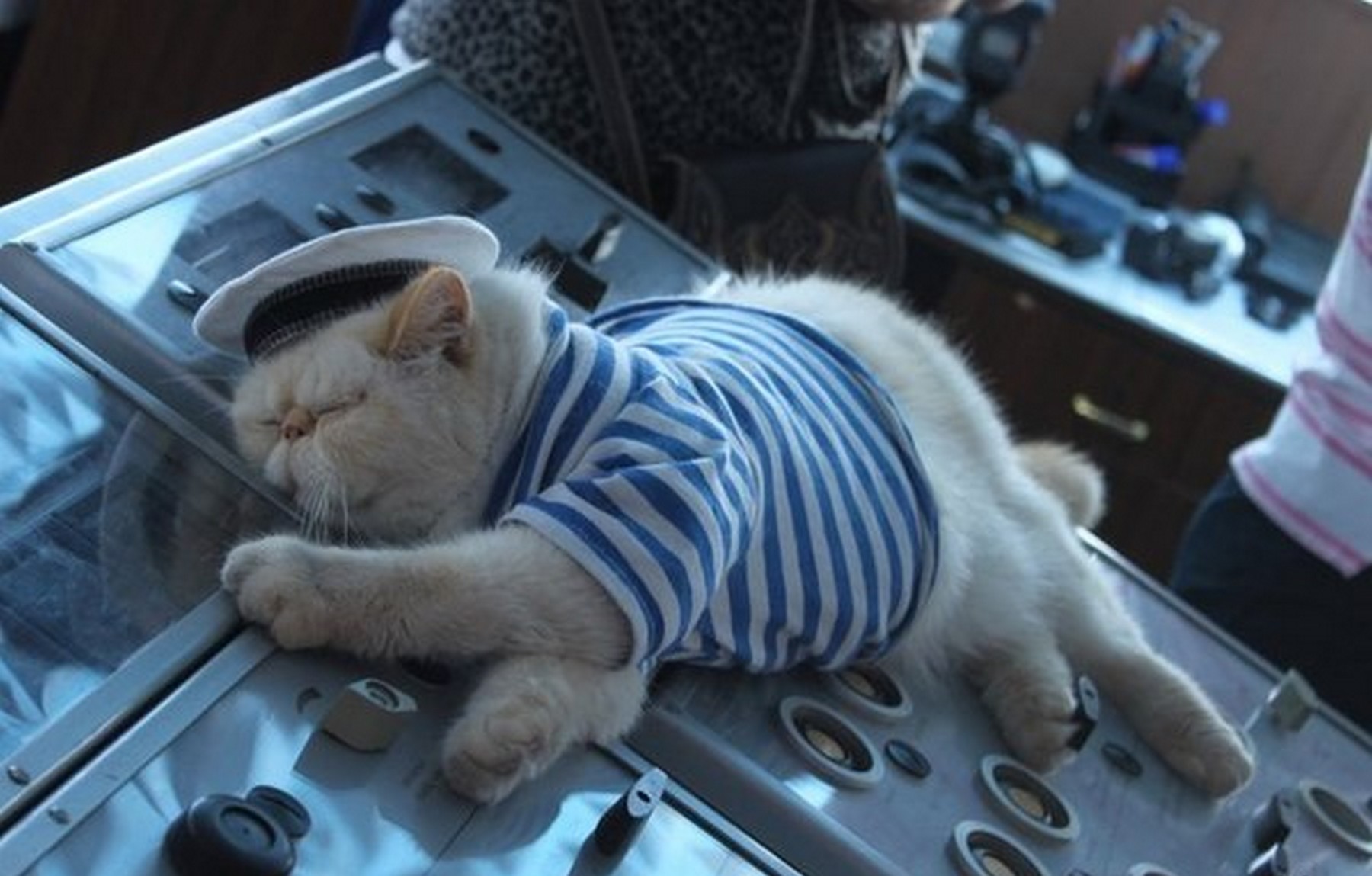 It was the pillar of your tertiary education, but somewhere along the line the insouciance of burning the midnight oil turned to chronic anxiety. The only thing that burns in your house after midnight now is the office block you’re torching in your dreams (statistically the most satisfying dream experienced by the proletariat). Caffeine is impotent, hardcore drum and bass is discombobulating and even The Panic Monster can’t keep you awake anymore. But sailors are fuelled by something stronger than caffeine and panic combined: fear of the unknown. The ocean is a capricious mistress and much like the writers of Lost, sailors don’t always know what’s going to happen next. They’re prepared for every eventuality. And that requires being awake. ALL THE TIME. 8. Letting things go 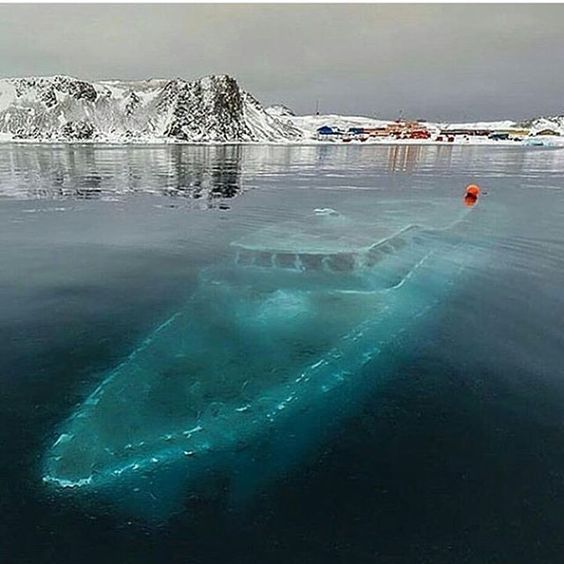 When something falls in the ocean it’s gone forever (unless you’re James Cameron). The only thing to do is forget about it and move on while muttering something profound like ‘It belongs to the ocean now, man.’ At sea if you don’t learn to let things go, you drown. Sailors would make great psychologists. 9. Democracy  Jokes. Sailors don’t know what that is. On a boat the captain is always right. Even when he’s not. by Tyson Jopson 2445
Юмор / 9 повседневных вещей, в которых любой моряк надерет вам зад« : 12.09.2016, 22:44:58 » this topic in English  Вы, возможно, и сами не промах и объехали полсвета. У вас в запасе целый арсенал впечатляющих уловок, которым вы обучились, путешествуя налегке по Бирме. Вы способны открыть бутылку вина ботинком и приготовить пахлаву чуть ли не из дождевой воды. Но всегда найдется тот, кто будет лучше, чем вы. И да, это моряки. Это настоящие брутальные парни (и девчонки!), cпособные жевать наждачку в вакуумной упаковке и стирать пот пойманной на лету чайкой. Это люди, не один раз проплывшие вокруг света и готовые находиться в океане в любую погоду. В море их таланты жизненно необходимы для выживания, на суше они могут показаться просто сверхчеловеческими. Сам я не моряк и не рвусь к жизни в океане. Я слишком сильно люблю лежать в тенечке и лениво переваривать обед. Но недавно я получил возможность пообщаться c яхтсменами, принимавшими участие в гонке Volvo Ocean Race. К слову, это явно не просто группа энтузиастов. Вот девять простых вещей, в которых они обойдут вас без особых усилий. 1. Параллельная парковка  Знаю, знаю. Вы просто великолепны в искусстве параллельной парковки. Возможно, вы даже достойны звания «Лучший водитель года». Однако в вашем словарном запасе никогда не существовало таких слов как «трехточечный поворот». Вы — любитель, и убедиться в этом легко. Попробуйте загнать пожарный грузовик без зеркал заднего вида в автомойку во время грозы. Моряки с легкостью сделают это на воде. 2. Идти прямо, когда пьян  Ваша невозмутимость на лице — настоящий фарc. Мы знаем, сколько стопок текилы вы опрокинули, и как вы, обивая углы, пытались добрести до ванной. Если вы не моряк, то вас выдадут ноги. Жизнь на воде учит правильно распределять центр тяжести. Чем больше жидкости в моряках, тем прямее они идут. В общем, если вы заметите шатающегося матроса — просто купите ему выпить. 3. Двусмысленность выражений  Парусная терминология — это океан, кишащий метафорами, каламбурами и двойными смыслами. Резерв нелепо звучащих слов в повседневной жизни просто неисчерпаем. Однако хихикать над такими словами как, например, "выбленочный узел" могут только сухопутные крысы. 4. Грамотно задавать направление  «Значит, поверните направо у дерева, затем пройдите школу, а, может, это и тюрьма. В нескольких кварталах от нее находится дорога. Я не могу вспомнить ее название, лучше позвоните, когда доедете». Это не координаты. Если бы люди научились задавать точные направления, дыра в озоновом слое определенно уменьшилась бы. Моряки знают это, а они далеко не единственные, кто жгут горючее. Они также знают, что в океане расплывчатые указания могут привести к смерти. Или, того хуже, в Порт-Элизабет. 5. Одеваться по погоде  Моряки нутром чуют плохую погоду задолго до того, как она испортится. Если вы не знаете, что надеть — просто найдите моряка и оденьтесь как он. Кроме погон. Никогда не носите погоны. 6. БДСМ  Это не выдумка. Вы определенно не умеете управляться с веревками. Качественно и быстро завязать бабий узел — это не то же самое, что завязать шнурки. Здесь есть свои нюансы. Простое незнание может легко привести к жертвам — попробуйте потом объяснить это полиции! Моряки помнят все существующие варианты узлов. У них бы получилось перевязать рестлера праздничной лентой. И, что более важно, развязать его впоследствии. 7. Не спать ночи напролет  Беззаботное бодрствование допоздна со студенческих времен не прошло для вас даром. Единственное, что теперь может гореть в вашем доме после полуночи — это здание офиса во сне (статистически наиболее желанная мечта любого пролетариата). Кофеин бессилен, и даже хардкорный драм-н-бэйс не заставят вас проснуться. Но моряки бодрятся чем-то покрепче кофеина: страхом перед неизвестностью. Океан — капризный хозяин, и моряки, как и сценаристы «Lost», не всегда могут предугадать, что произойдет в следующий момент. Они готовы к любой неожиданности. А это требует бодрствования. Все время. 8. Позволять всему идти своим чередом  Если что-то упало в океан — оно ушло туда навсегда (только если вы не Джеймс Камерон). Единственное, что нужно сделать, это забыть об этом и двигаться дальше, бормоча глубокомысленное: «Теперь это принадлежит океану, мужик». На море, если вы не научитесь мириться и отпускать — вы утонете. К слову, из моряков получились бы отличные психологи. 9. Демократия  Шутка. Моряки не знают, что это такое. На лодке капитан всегда прав. Даже тогда, когда это не так.
|

Нет пользователей онлайн.
Здесь может быть Ваша реклама!
|